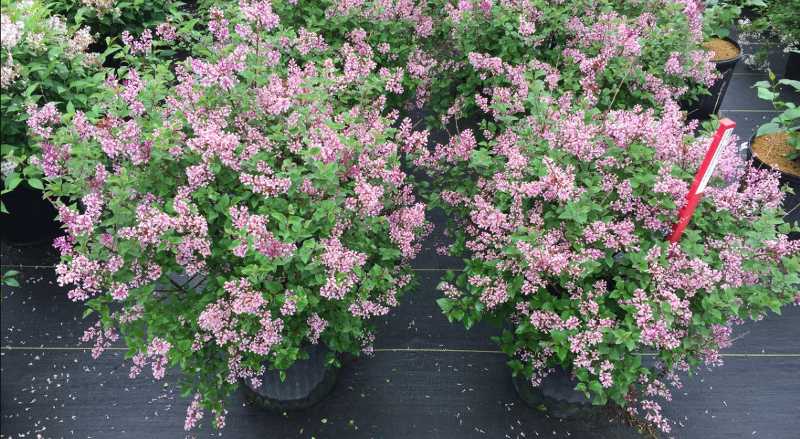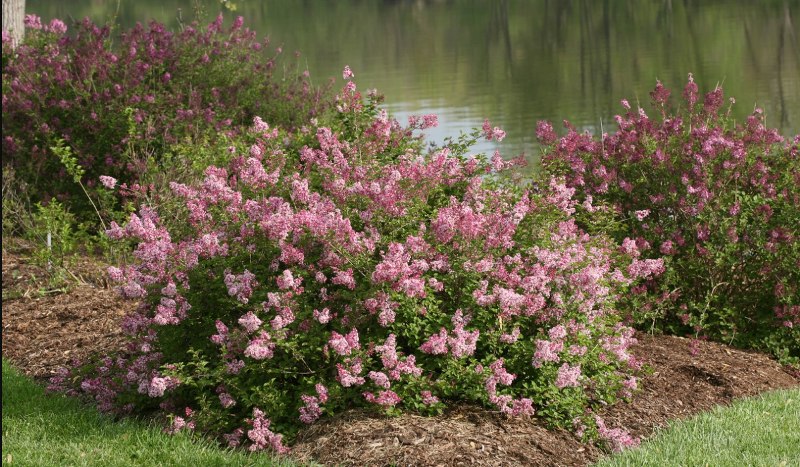The common lilac, (Syringa vulgaris) is a perfect addition to any home garden. Although generally thought of as purple in color, there are actually seven different colors of lilac flowers: white, violet, blue, lavender, pink, magenta and purples with many shades within each color. This fragrant bush is very versatile and can be planted as an ornamental piece, a border plant, a flowering hedge, or planted in a container.

The lilac grows 12-15 feet tall and 10-12 feet wide. There are smaller dwarf varieties, such as our Bloomerang® Dwarf Pink Lilac, that mature at 4-6 feet tall and 3-7 feet wide. Lilacs need at least 6 hours of sun a day and lots of space to grow. This shrub thrives in well- drained, alkaline soil.
What You Need To Plant Lilacs
The main tools you will need are:
- Digging shovel
- Garden spade
- Gloves
- Water hose
- Wheelbarrow- for moving the Lilacs
- Tarp- to protect and mov a large root ball

Where to Plant Lilacs
For the best flowering, lilac shrubs should be planted in an area that gets a minimum of 6 hours of full sun every day. Lilacs like slightly alkaline (6.5 to 7.0 pH), moist, well drained soil. Avoid planting your lilac in an area where grass is underneath. Regular watering of the grass can be too much moisture for the plant. Lilacs benefit from slow watering once every 7- 10 days.
LIlacs have a lovely fragrance and a colorful look. They should be enjoyed near a window, door, or a main pathway. When you decide on the perfect area for your lilac, you will need to dig a hole twice as wide and just as deep as the plant’s root ball.
Lilac Spacing
Lilac shrubs are an excellent choice for any garden area. They can be planted alone, in small groups, mixed in borders, or as a deciduous hedge. Lilac roots need their space as they will spread to about 1 ½ times the width of the shrub. Their roots are not considered invasive, but a shrub that's 10' wide will probably have roots extending out about 15' in all directions. Be sure you leave enough space between the shrub and the next plant or structure.
Space medium-sized lilacs that are 6 to 8 feet tall at maturity 2 to 4 feet apart. For larger lilacs, which will be taller than 8 feet at maturity, plant about 4 to 6 feet apart. Once the plants mature, larger lilac plants can spread to 10-12 feet wide. If you are concerned about limited space in your garden area, we suggest a Bloomerang® Dwarf Pink Lilac. This dwarf shrub will be 3-7 feet wide at maturity.

Steps To Plant Lilacs
Once you have found the perfect place for your lilac plant, dig hole twice as wide and just as deep as the container. You may want to dig the hole a bit deeper if you choose to add compost. Carefully take the lilac out of the container and score the roots to get them ready to spread out. This helps to encourage root growth out into the soil.
Place your plant in the ground and fill the hole. Apply a loose layer of mulch (2-3 foot around the base). Water thoroughly. Once the shrub is established, water every 7-10 days.
Step 1 - Pick out a good location
Step 2 - Dig the hole
Step 3 - Add compost or manure to the dirt
Step 4 - Score the roots.
Step 5 - Position the root ball even with the ground
Step 6 - Firmly fill in the dirt
Step 7 - Add mulch
Step 8 - Water thoroughly
When to Plant LIlacs
The best time to plant a lilac is in the fall. Wait until the leaves have dropped, yet, plant before the ground freezes. Lilacs planted in the fall will have a better chance to survive because the new roots will have time to get established before the plant leafs out in the spring.
The next best time to plant is in the early spring, after the ground thaws. Plant the lilac before it’s buds start to unfold.
Transplanting Lilacs
If you are thinking that your lilac plant will look better in a different location, we recommend transplanting a root shoot instead of relocating the entire plant. Although it is possible to move an entire mature plant, you will invest a lot of time and muscle into this task.
If you transplant your mature lilac, dig a trench around the plant. Next, using a sharp shovel, dig at a 45 degree angle around and under the root ball. As you work your way around, loosen and lift the root ball from the soil. Cut large roots as needed. You will need to get as large of a root ball out as you can. Place the plant and root ball into a wheelbarrow and move.
Plant the root ball in a hole twice as large as the root ball. Fill in with soil around the rootball and keep it watered regularly for the next year or two.
Transplanting a lilac shoot, sometimes referred to as a sucker, is much easier. Odds are good that they will grow and thrive in a new location. During the spring, after the plant blooms, use a shovel and cut a shoot from the main plant. Dig down at the base of the plant including as much of the root system as possible. Plant in the center of the new hole.
 |
Author Chris Link - Published 12-16-2020 |
